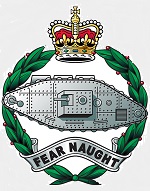Corgi CC60613 British Cromwell Mk. IV Tank - "Blenheim", 2nd Armoured Battalion, Welsh Guards, 6th Guards Armoured Brigade, Brussels, Belgium, September 1944 (1:50 Scale)
"Cymru am Byth" ("Wales Forever")
- Motto of the Welsh Guards
 The Cromwell tank was used by the British Army during the later stages of World War II. The Cromwell was ordered in 1941 and intended to replace the lightweight Crusader "cruiser" tank by being more heavily armoured, and, it was hoped, more survivable in battle. Its greater weight was to be driven by a 600-horsepower Rolls Royce Meteor engine, a derivative of Rolls Royce's line of aircraft engines. Initial models, however, were powered by other engines and were designated Cavaliers and Centaurs when they entered service in mid-1942. The first genuine Cromwells with Meteor engines entered service in early 1943.
The Cromwell tank was used by the British Army during the later stages of World War II. The Cromwell was ordered in 1941 and intended to replace the lightweight Crusader "cruiser" tank by being more heavily armoured, and, it was hoped, more survivable in battle. Its greater weight was to be driven by a 600-horsepower Rolls Royce Meteor engine, a derivative of Rolls Royce's line of aircraft engines. Initial models, however, were powered by other engines and were designated Cavaliers and Centaurs when they entered service in mid-1942. The first genuine Cromwells with Meteor engines entered service in early 1943.
The Cromwell tank weighed about 27 tons and had a top speed of 38 miles per hour and a range of between 80 and 170 miles, depending on the terrain. It was initially armed with a 75mm gun and two 7.92mm machine guns. The Cromwell's main assets were its speed, maneuverability, and ease of repair. It first entered battle in large numbers in mid-1944, during the Normandy Invasion and the ensuing campaign across northern France. From Normandy on, Cromwells and American Sherman tanks formed the backbone of British armored divisions. Like the Shermans, however, most Cromwells were outgunned by the more powerful German Panther and Tiger tanks. Cromwell tanks served in British armies until the war ended in Europe in mid-1945.
This particular 1:50 scale replica of a British Cromwell Mk. IV cruiser tank was attached to the 2nd Armoured Battalion, Welsh Guards, 6th Guards Armoured Brigade during 1944.
Sold Out!
Dimensions:
Length: 5-inches
Width: 2-inches
Release Date: October 2019
 Historical Account: "The Welsh Guards" - The Welsh Guards (WG; Welsh: Gwarchodlu Cymreig), part of the Guards Division, is one of the Foot Guards regiments of the British Army. It was founded in 1915 by Royal Warrant of George V.
Historical Account: "The Welsh Guards" - The Welsh Guards (WG; Welsh: Gwarchodlu Cymreig), part of the Guards Division, is one of the Foot Guards regiments of the British Army. It was founded in 1915 by Royal Warrant of George V.
The Welsh Guards were increased to three battalions during the Second World War. The 1st Battalion fought valiantly in all the campaigns of the North-West European Theatre. The 2nd Battalion, part of the 20th Independent Infantry Brigade (Guards), fought briefly in Boulogne, France, in late May 1940 while the 1st fought in the battles of Belgium and France as part of the British Expeditionary Force (BEF) GHQ Troops. In May 1940, at the Battle of Arras, the Welsh Guards gained their second Victoria Cross by Lieutenant Christopher Furness, who was subsequently killed in action. The 1st Battalion was subsequently part of the retreat to Dunkirk, where they were involved in the legendary Dunkirk evacuation that saw nearly 340,000 Allied troops return to the United Kingdom, against all odds.
The 3rd Battalion, Welsh Guards, which was formed at Beavers Lane Camp in 1941, fought throughout the arduous North African Campaign, in the Tunisia Campaign and the Italian campaigns in 1943.
While they battled on in those theatres, the 1st and 2nd joined the Guards Armoured Division, with the 1st Battalion being infantry, assigned to the 32nd Guards Brigade, and the 2nd Battalion being armored, part of the 6th Guards Armoured Brigade. The two battalions worked closely, being the first troops to re-enter Brussels on September 4th, 1944, after an advance of 100 miles in one day in what was described as 'an armored lash unequaled for speed in this or any other war' led by Major-General Sir Allan Henry Adair, the divisional commander.





 British Cromwell Tank Mk. IV Tank
British Cromwell Tank Mk. IV Tank 


